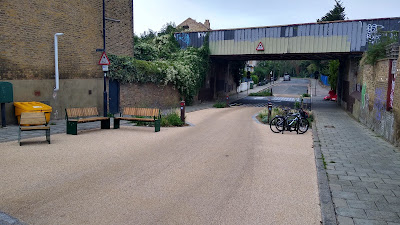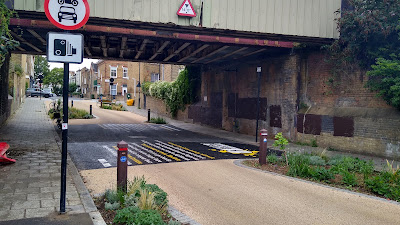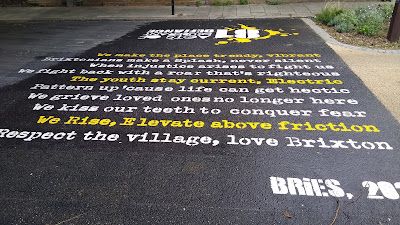Just over a two years ago, I paid a visit to the Railton Low Traffic Neighbourhood, to the southeast of Brixton town centre in south London. I revisited because I had seen photos on social media of the project being made permanent and I wanted to have a look myself.
Functionally, the project is the same as it was on my last visit with restricted motor vehicle access to Atlantic Road from Coldharbour Lane at the northwestern end (below), with that first section essentially creating a cul-de-sac just beyond. At the southeastern end, a bus gate has been retained near Herne Place which means there is a low traffic link from Brixton to Herne Hill station.
Crucially, Shakespeare Road remains closed to motor traffic at Mayall Road and so with pretty small scale work, an entire area has been freed from being a cut through for motors while maintaining full access to buses, emergency vehicles and service vehicles.
So on that basis, this post is actually quite short because the previous one went into a bit more of that detail. The key thing is how the London Borough of Lambeth has made the project permanent and so let's look at the Atlantic Road end a bit more closely. The first 35 metres (from Coldharbour Lane) is only for buses and loading permit holders, and it is dominated by new planting (above).
In theory the only way in for loading permit holders would be from the opposite arm of Atlantic Road given the banned turns from both arms of Coldharbour Lane and so only those in the know would go that way. Other deliveries can be made by accessing Atlantic Road via other routes. Because this first section restricts motor traffic, additional footway space has been provided along with seating (above) and cycle parking.
The modal filter just south of Marcus Garvey Way has also been upgraded (above) so it is more obvious that people shouldn't be driving through southbound. Northbound is allowed due to the way the local traffic circulation plan has been arranged. This is a bit of a theme and while needing to allow buses through, the road layout has been changed to help reinforce the prohibition of general traffic intention of the design.
One issue I have is with the signage which in common with the entrance from Coldharbour Lane uses the written "BUS GATE" marking with the no motor vehicles traffic sign (above). I'm afraid that this is not an approved combination and Lambeth needs to either remove the markings or swap the signs to one of the 953 series (one for the sign geeks) within which exemptions to the traffic regulation order can be made for "authorised vehicles" but not permit holders.
Other main change has been at Shakespeare Road where a short section of street has been essentially pedestrianised with the temporary materials giving way to permanent materials which work to explain to drivers they shouldn't be here (above). To the north of the railway, Shakespeare Road is now a quiet cycle route up to Loughborough Junction station.
The street layout in the wider area is a bit awkward due to the railway cutting through, and so from an emergency access point of view, the pedestrianised section of street has space for vehicles to pass through with CCTV enforcement. The layout is such that there isn't a clear view of the route ahead which is another design reinforcement to drivers that they are not permitted to pass. The seating and planting work to block this view through while allowing a route that standard fire engines can tackle.
The photograph above is from the north looking south and again, the winding nature of the emergency route can be seen with the planting providing the visual break. Below is a closer look at the planting here which are all rain gardens with a square of granite blocks providing a bit of water energy dissipation before the planting.
There are also poems from local poets within the area as part of a local heritage trail (below).
So, while the project hasn't functionally changed from my last visit, the permanent materials and planting don't just look good, they help reinforce the layout to make it a bit more self-explaining to drivers which I think is a good thing. Even though people driving should understand traffic signs, making it easy to understand counters the often claimed confusion argument. So, I shall leave you with a quick video of the project and I wonder if you'll see the little surprise (just before the 3 minute mark)?












